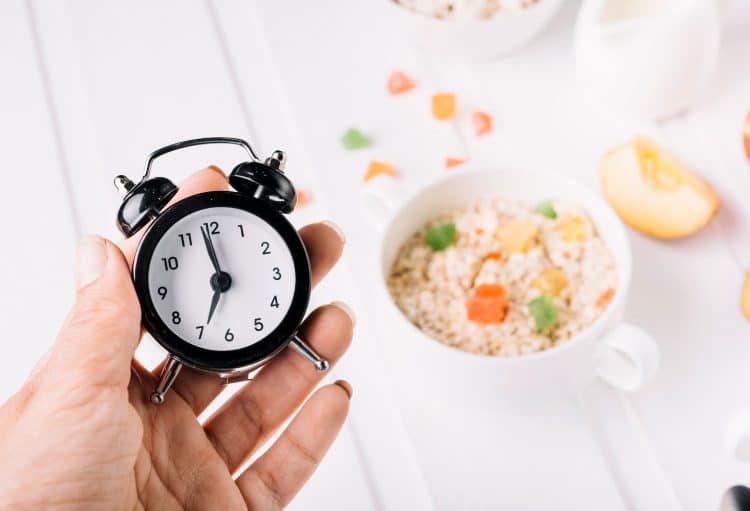Craving for comfort food is one of the truest human emotions. Every person has a go-to food for when they are happy, sad, idle, or anxious. Cravings are natural, and you cannot eliminate them. However, like other human emotions, they can be controlled or limited.
As someone who has been training for over 17 years, I’ve been dealing with cravings and hunger pangs for a very long time.
However, over the years, I have developed ways to curb these cravings. These strategies have not only helped me manage my hunger, but they have also played a pivotal role in boosting my overall health and well-being, managing my weight, and improving my mood.
15 Scientifically Proven Hunger Hacks

Use the following hacks to curb cravings and move toward your dream physique:
Dietary Tweaks:
These diet changes will help kickstart your transformation:
Level Up Your Fitness: Join our 💪 strong community in Fitness Volt Newsletter. Get daily inspiration, expert-backed workouts, nutrition tips, the latest in strength sports, and the support you need to reach your goals. Subscribe for free!
1. Prioritize protein and fiber-rich foods
No two foods are created equal. While one food source can cause weight gain, the other can help you pack on lean muscle tissue. Whether you are trying to build muscle or lose weight, you must prioritize protein, as it can keep you satiated for extended periods and reduce the possibility of unexpected cravings. (1)
Fiber-rich foods like lentils, apples, carrots, and oatmeal are other must-haves in your diet. Not only do they improve digestion and bioavailability of other nutrients, but they are incredibly nutrient-dense, which can help curb hunger pangs.
2. Choose complex carbs over simple sugars
Simple sugar, or simple carbohydrates, is the most basic form of sugar and can be found naturally in fruits, vegetables, and nuts, as well as in milk and milk products. Although this versatile food source isn’t necessarily bad for your health, they are digested quickly by the body, which can leave you starving within a few hours of eating.
On the other hand, complex carb sources like peas, beans, whole grains, and vegetables are made up of three or more sugar molecules. It takes your body longer to break them down to use as energy. The entire process also delays the onset of hunger.
3. Stay hydrated
Most people usually mistake thirst for hunger. The human body is 70 percent water; a low water intake can throw off your hormonal balance, which can spike your hunger levels.
Drinking water at regular intervals throughout the day can keep you feeling full and reduce the chances of overeating. Whenever you are starving, drink a glass of water before eating. A study found that people who drank a glass of water before a meal ate 75 fewer calories per meal on average. (2)
Drink at least a gallon of water daily to avoid dehydration and curb cravings.
4. Mindful eating practices
Mindful eating starts before you sit down to eat your meal. You must be diligent while preparing your grocery list. Think of each food’s macro and micronutrient content and if they align with your goals.
Stick to the aisles with healthy foods during the grocery haul to ensure you don’t buy stuff you don’t need.
Be mindful about your food. Take a moment to observe and appreciate your meal, and savor each bite. Chewing thoroughly can help improve digestion as most of the work is done in the mouth itself.
When you are considerate about your food, it minimizes the chances that you will feast on junk even when you are starving.
5. Include healthy fats in your diet
Many consider dietary fats the cause of their weight gain. However, avoiding healthy fats does more harm than good. Fats are essential for several body functions, including hormonal balance, vitamin absorption, energy production, joint and heart health, and cognitive function.
Plus, dietary fats are incredibly nutrient-dense. One gram of fat has nine calories, whereas one gram of carbs and protein has four calories each. It takes your body longer to break down dietary fat to produce energy and help stave off hunger pangs.
6. Chew gum or mints
When you chew gum, it distracts your taste buds and keeps your mouth occupied. This stimulates the release of saliva and digestive enzymes, which tricks your mind into feeling full.
Research shows that chewing gum can reduce impulsive eating and help prevent binge eating (4). Pop a gum whenever you are starving for immediate (but short-term) relief. However, you cannot completely overlook the hunger signals. You must eat a balanced, nutrient-dense meal as soon as you can.
Also, you must pick a chewing gum without added sugar, as it can hurt your gut flora and transformation objectives.
7. Intermittent Fasting
Although this might sound counterintuitive, intermittent fasting (IF) is one of the most effective ways to control cravings. Frequent cravings can arise from hormonal imbalances. IF can help reset your metabolism and regulate ghrelin and leptin levels. It can also improve insulin sensitivity, which can prevent blood sugar level spikes. (5)
Pick an IF protocol that suits your lifestyle and goals, and stick to it for at least eight to 12 weeks to experience its effectiveness in controlling frequent cravings and hunger pangs.
Level Up Your Fitness: Join our 💪 strong community in Fitness Volt Newsletter. Get daily inspiration, expert-backed workouts, nutrition tips, the latest in strength sports, and the support you need to reach your goals. Subscribe for free!
8. Brush your teeth
This is one of the oldest but an often-overlooked trick to curb cravings. Although you can employ it at any point in the day, it is the most effective after dinner.
Many people are in the habit of eating something sweet, like a cake or ice cream, after dinner. Brushing your teeth right after dinner distracts you from the urge to snack. Plus, it signals to your brain that it is time to sleep, reducing your desire to eat.
Not only that, brushing removes plaque and food particles from your teeth and gums, which can eliminate microbe buildup that can make you feel hungry.
9. Drink green tea or coffee
Green tea and coffee are incredibly effective at suppressing appetite and increasing satiety. They contain caffeine and catechins, which can help boost metabolism and burn fat. Green tea also contains EGCG, which is a compound that can reduce the desire to eat.
I like to have a cup of coffee at regular intervals between my meals to curb cravings, and it works like magic. Whenever I miss my coffee, my hunger pangs are off the charts.
10. Distract yourself with a hobby or activity
This is one of the most underrated ways to curb cravings. Most cravings pop up when you are idle. If you have been experiencing consistent cravings, consider taking up a new hobby or activity.
Learning something new will take your mind off junk food and will likely curb the desire to eat unhealthy food. You don’t even have to learn something new. Practice what you love doing, and it will deliver enough mental stimulus to avoid cravings.
Lifestyle Changes:
A fitness transformation usually requires certain lifestyle changes. Start with these:
11. Get enough sleep
Sleep is when your body restores its hormonal balance to ensure optimal functioning. A lack of sleep or interrupted sleep can hamper your recovery and have several side effects, including increased cravings for junk food, irritability, high blood pressure, and even heart and kidney disease. (3)
Sleep deprivation can interfere with your work and personal life and can disrupt your fitness ambitions. Aim for at least seven hours of sleep each night to allow your body enough time to recuperate and function optimally.
12. Manage stress effectively
The human body ramps up cortisol (stress hormone) production to cope with stress. While cortisol can be incredibly useful in high-stakes fight-or-flight situations, chronic stress can lead to a whole host of health issues, including anxiety, depression, heart stroke, etc.
High stress levels can also lead to emotional eating, which is never a good thing if you’re trying to lose weight. People dealing with chronic stress should try yoga, meditation, journaling, or taking a walk to cope with their emotions.
I highly recommend consulting a healthcare provider if these methods don’t help. Remember, mental health is as important as physical fitness.
13. Avoid distractions during meals
Let’s be honest: most of us eat our meals while watching YouTube, Netflix, or Instagram reels. Distractions like these can increase the possibility of overeating. You should instead eat in a calm environment.
Limiting distractions also significantly lowers eating time and pushes you to evaluate your dietary choices. You are more likely to opt for healthy foods and eliminate unhealthy foods from your diet, which can keep you satiated for longer and help curb hunger.
14. Regular exercise
People who exercise regularly are more likely to stick to a healthy diet. Prepping your meals in advance ensures you have healthy food at hand throughout the day, preventing cravings and reaching out for processed food.
I recommend prepping a week’s worth of meals on your day off from work. Use this handy calculator to determine your ideal daily calorie and macronutrient intake goal as per your fitness objectives. Use a calorie tracker like MyFitnessPal to ensure you hit all the markers.
15. Don’t skip meals
Missing meals is one of the biggest blunders you can commit while trying to curb cravings. Skipping meals throws off the ghrelin and leptin hormones, which are responsible for controlling appetite and fullness and can help regulate body weight.
You are more likely to make poor dietary choices when you are starving. Prioritize eating on a fixed schedule to ensure a constant supply of energy and nutrients to your muscles and prevent cravings.
Conclusion
Frequent and uncontrollable cravings are among the biggest reasons why most people cannot achieve their fitness objectives. The 15 strategies in this article will help you conquer this battle. Start slow and small, experiment with different methods, and stick to what works for you. The results will speak for themselves.
Remember, you must not be too harsh on yourself and deprive yourself of comfort foods. One cheat meal a week can keep your cravings in check. When used in moderation, cheat meals can fast-track you to your dream physique.
If you have any queries about the ways listed in this article or need help implementing this into your routine, post them in the comments below, and I’ll be happy to help!
References:
- Leidy HJ, Armstrong CL, Tang M, Mattes RD, Campbell WW. The influence of higher protein intake and greater eating frequency on appetite control in overweight and obese men. Obesity (Silver Spring). 2010;18(9):1725-1732. doi:10.1038/oby.2010.45
- Davy BM, Dennis EA, Dengo AL, Wilson KL, Davy KP. Water consumption reduces energy intake at a breakfast meal in obese older adults. J Am Diet Assoc. 2008;108(7):1236-1239. doi:10.1016/j.jada.2008.04.013
- Institute of Medicine (US) Committee on Sleep Medicine and Research; Colten HR, Altevogt BM, editors. Sleep Disorders and Sleep Deprivation: An Unmet Public Health Problem. Washington (DC): National Academies Press (US); 2006. 3, Extent and Health Consequences of Chronic Sleep Loss and Sleep Disorders. Available from: https://www.ncbi.nlm.nih.gov/books/NBK19961/
- Ikeda A, Miyamoto JJ, Usui N, Taira M, Moriyama K. Chewing Stimulation Reduces Appetite Ratings and Attentional Bias toward Visual Food Stimuli in Healthy-Weight Individuals. Front Psychol. 2018;9:99. Published 2018 Feb 8. doi:10.3389/fpsyg.2018.00099
- Vasim I, Majeed CN, DeBoer MD. Intermittent Fasting and Metabolic Health. Nutrients. 2022;14(3):631. Published 2022 Jan 31. doi:10.3390/nu14030631












